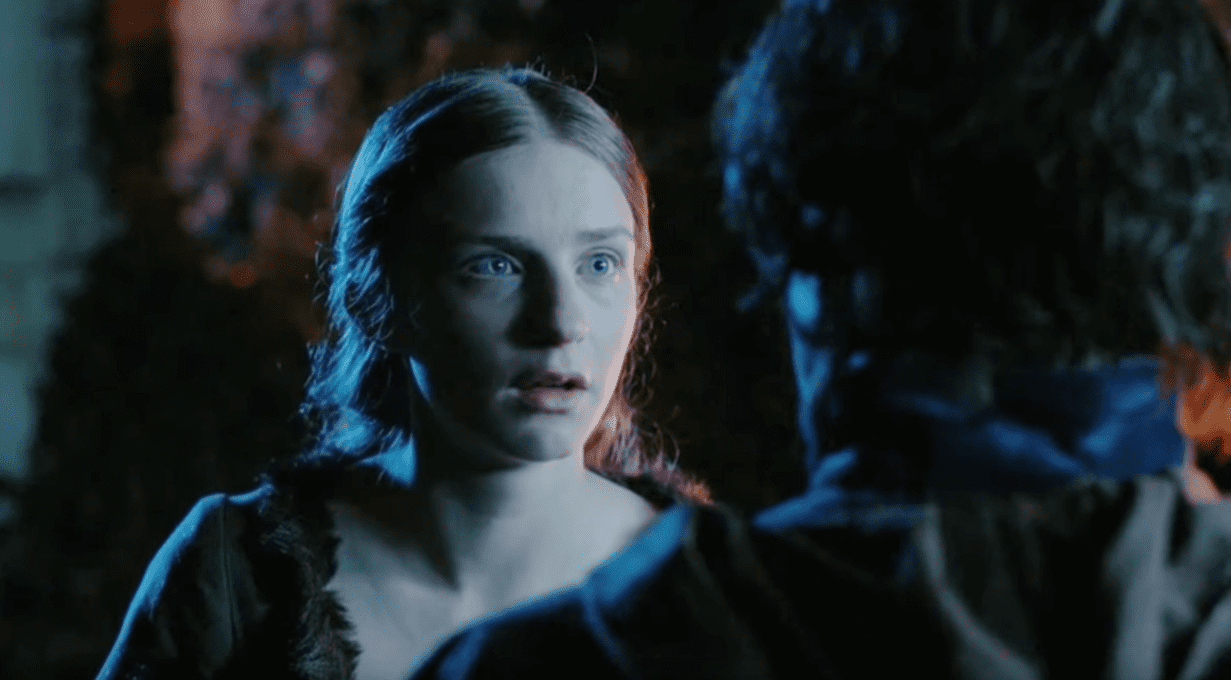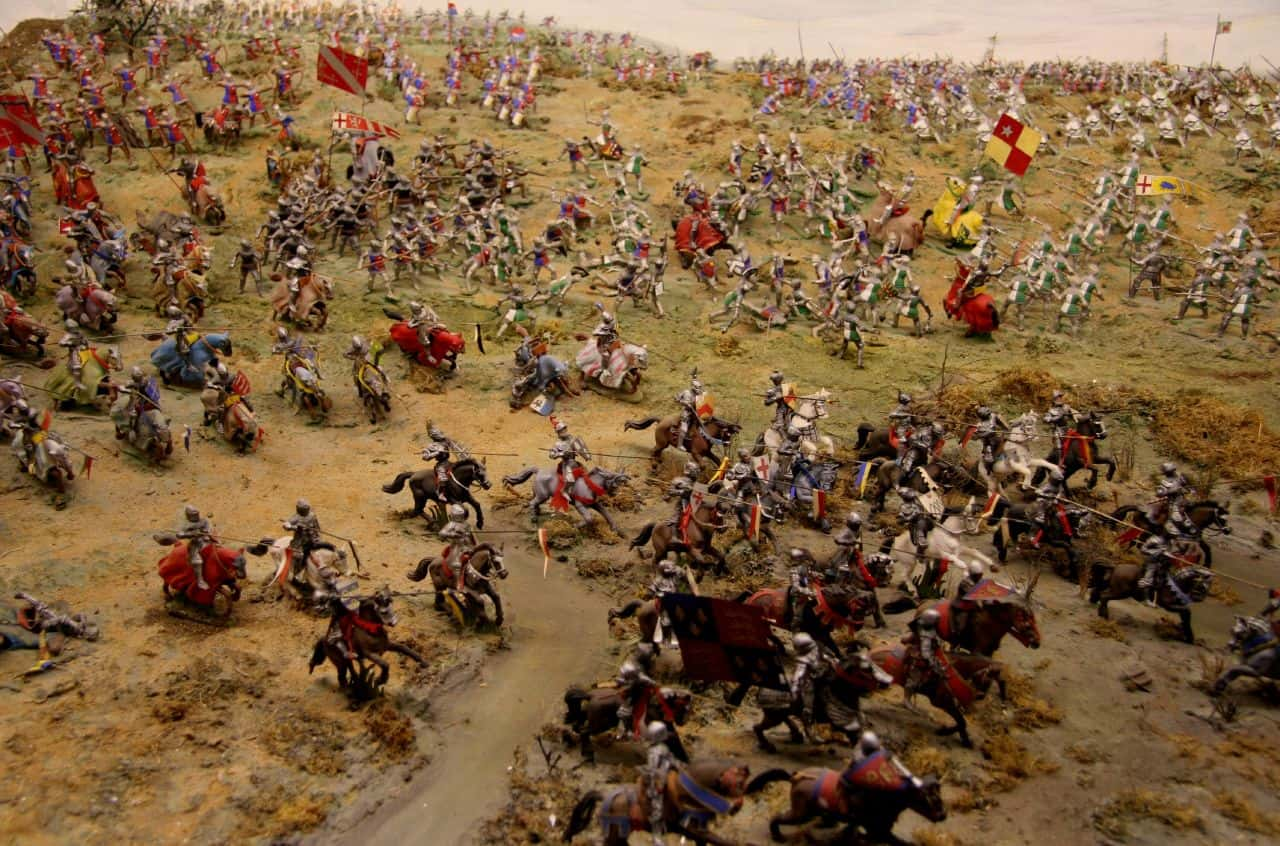Anne Neville was born in 1456 in Warwick Castle, Warwickshire, England, and was the younger daughter of Richard Neville, Earl of Warwick, and Anne Beauchamp. She is best known for being the Princess of Wales while being married to Edward of Westminster, and then as Queen of England with her second marriage to Richard III. Below are facts about the forgotten queen.
1. A Tumultuous Time
Anne Neville’s birth occurred at the beginning of the conflict between the houses of Lancaster and York for control of the English throne. The wars became known as the Wars of the Roses because the feuding houses had white and red rose as their badges.
2. Kingmaker
Anne's father Richard Neville was known as the Kingmaker because of the amount of influence he had in who succeeded the English throne. Neville was instrumental in defeating Henry VI and installing Edward IV on the English throne, but by 1469 he had switched his support to the Lancastrian cause of returning Henry VI to the throne.
Pick a side, Kingmaker!
3. No True Description
Exactly what Neville looked like is unknown, but she is described as beautiful by John Rous—a chronicler who actually knew her. There is a drawing of Neville taken from the Salisbury Roll, which portrayed the Royal Family, but since it looks like it was drawn by a five-year-old, it’s probably not that accurate.
Hey, the Renaissance hadn't quite hit England yet, give them a break.
4. A Major Catch
Neville's mother Anne Beauchamp was a major heiress herself. She was the heir to the Beauchamp-Despenser fortune (her father and her mother had a lot of money) and upon her death, the fortune passed to her two daughters. The combination of their noble birth and future inheritance made both young Anne and her sister Isabel highly desirable for marriage.
 The White Queen, BBC Drama Productions
The White Queen, BBC Drama Productions
5. Making Her Acquaintance
The first meeting of Richard III and Neville did not occur at their marriage. The pair had actually become acquainted as children when Richard was sent to Middleham Castle in Wensleydale to be mentored by his older cousin and Anne’s father, the Earl of Warwick. Can't you just imagine little Anne and Richard playing together in the field?
However, there’s no record to suggest that they were childhood sweethearts or how well they knew each other at all, but they probably didn’t hate each other.
6. Strategic Engagement
At one point, the Earl of Warwick arranged to marry his daughters Isabel and Anne to George, Duke of Clarence, and his brother, the future King Richard III. The engagements were broken when Warwick rebelled against Edward IV. Suddenly Public Enemy Number One, the Neville family fled to France to wait it out.
Scandalously, though, Isabel and the Duke married there without the King’s permission. Risky!
7. Proving His Loyalty
After the rebellion, the Earl of Warwick had to do something to prove his loyalty to the new King Henry VI, and more importantly, his queen, Margaret of Anjou, who was understandably not fully convinced that he really had switched to their side of the war. To prove his trustworthiness, he married his daughter Anne to their son Edward of Westminster, the future Prince of Wales, at age 14.
8. Broken Promises
Isabel’s husband, the Duke of Clarence, was the brother of King Edward IV, but he also switched sides in the Wars of the Roses to try and take the throne for himself, with a promise of support from the Earl of Warwick. I know, things are getting really complicated here, and it doesn't help that all these people were related.
Basically, all you need to know is that a bunch of man-children wanted to be King, and Anne Neville's Daddy wanted help them.
9. Opposite Sides
Isabel and Anne temporarily found themselves on opposite sides of the war thanks to their respective husbands. That would certainly make for some awkward family dinners!
 The White Queen, BBC Drama Productions
The White Queen, BBC Drama Productions
10. Short-Lived Marriage
Anne and Edward weren’t even married a year before Edward of Westminster was killed in the Battle of Tewksbury. The pair married in December of 1470 and he was killed in May of 1471. Alas poor Edward, she barely knew you.
11. They Never Did It!
Margaret of Anjou and Anne's father the Earl of Warwick were bitter enemies who only sort of put aside their differences out of necessity. Despite agreeing to allow Anne to marry her son Edward, she wanted to keep her options open, so she might have told Edward not to consummate their marriage in case someone better came along for him to marry.
Whether they did or didn’t have intimate relations, there were no children from the marriage, so Anjou could spin it any way she wanted.
 The White Queen, BBC Drama Productions
The White Queen, BBC Drama Productions
12. A Change in Fortune
Neville’s mother Anne Beauchamp became the heir of her family's fortune quite unexpectedly after the death of first her older brother, and then his young heir.
13. Suffering Losses
Fighting for the Lancastrian side turned out to be the wrong choice for Neville’s father, the Earl of Warwick. On April 14, 1471, the Yorkists won the Battle of Barnet, and he and one of Anne's uncles were both killed. Half-orphaned and widowed in less than a month and not even sixteen. Poor Anne!
 The White Queen, BBC Drama Productions
The White Queen, BBC Drama Productions
14. Sanctuary
Upon becoming widowed, Neville’s mother hightailed it to Beaulieu Abbey for sanctuary, knowing that as the widow of a traitor to the crown, she could be charged with treason and for conspiring in the rebellion. She remained there either voluntarily or as a prisoner for two years, while her money and lands were held by her son-in-law, the Duke of Clarence.
 Wikimedia Commons, Wulfrunian1
Wikimedia Commons, Wulfrunian1
15. Prisoner
With her husband and father’s deaths, Neville was also in danger. Upon her return to England, she was taken prisoner and held at Coventry. Her sister and brother-in-law, the Duke of Clarence, agreed to take her in, but not out of the goodness of their hearts. They pretty much just wanted to get their hands on her money, and since she had nothing of her own and needed a protector, it was the best she could do at the time.
 The White Queen, BBC Drama Productions
The White Queen, BBC Drama Productions
16. By Right of His Wife
Anne’s infamous father was not an Earl by birth, but through his wife. According to English law at the time, a married woman could not legally hold lands, and thus Richard Neville inherited the Earldom of Warwick and was able to control his wife’s wealth. It's always a raw deal for the women.
 The White Queen, BBC Drama Productions
The White Queen, BBC Drama Productions
17. Power Struggle
The widowed Anne became a pawn in a political tug-of-war between her brother-in-law Clarence and his younger brother Richard, the Duke of Gloucester (Future King Richard III), who was pretty interested in marrying her. But don't go thinking that this was some overblown romance between Anne and these princely men.
Anne was set to inherit half of her mother’s estate, and if Clarence could keep her from getting married and make her a nun, he’d effectively control all of her money. Likewise, Richard wasn't about to let all that money go to God.
18. One Way or the Other
Anne eventually escaped from Clarence's clutches, but how she did so is the subject of conflicting stories. In one version, Clarence dressed Anne as a servant and hid her in a cookshop so that Richard couldn’t find her—but he found her anyway. Another story claims that it was Richard who snuck Neville out of Clarence’s house and hid her away until he could marry her.
So we're still not sure exactly what happened, but a disguise and a cookshop seem to have been involved!
 The White Queen, BBC Drama Productions
The White Queen, BBC Drama Productions
19. Under Protest
When Richard announced his intent to marry Neville, Clarence completely lost it. If his sister-in-law married again, he’d lose control over her half of her mother’s inheritance, and he did everything he could to keep that from happening. Finally, Richard had to give up much of Anne's rightful inheritance to lands in order to marry her.
 The White Queen, BBC Drama Productions
The White Queen, BBC Drama Productions
20. In Her Own Best Interest
Living under the thumb of her sister and brother-in-law wasn’t the best situation for Anne, and finding a new husband was definitely in her best interest. Although Richard III was obviously keen on Neville, she also likely knew that he was her opportunity to escape her imprisonment and probably the only way that she’d ever get her hands on any of her money.
The fact that he was a duke and a prince didn’t hurt either.
 The White Queen, BBC Drama Productions
The White Queen, BBC Drama Productions
21. Consent Is...Unnecessary?
Technically, Richard III’s kidnapping of Neville would have been called abduction in medieval terms, but it didn’t mean quite the same thing as it does in current terms. Supposedly it was done with “the full consent of the lady,” so there would have been no consequence to either party.
 The White Queen, BBC Drama Productions
The White Queen, BBC Drama Productions
22. Money or Love
Richard III’s motivation in marrying Anne has always been the source of much speculation. It’s possible that it was a real love match, but since no record exists of their true feelings for one another, it’s hard to say. The more likely scenario is that he was more interested in her money and her lands, which would have made him equally as powerful as his brother.
A third possibility is that he both loved her and wanted the money. Who says you can’t have your cake and eat it too?
 The White Queen, BBC Drama Productions
The White Queen, BBC Drama Productions
23. I Forgive You
With her father and husband dead, the new King Edward IV had to decide what to do with the widowed Anne. This was probably one time where being a girl was to her advantage. Despite the actions of her family, she wasn’t personally involved in the War and posed no real threat to the king. As long as she was willing to submit to him, he was quite happy to pardon her.
It was also to her fortune that she wasn’t pregnant with her first husband's child, or else that would have made her (or at least her offspring) a problem that needed, er, "handling."
 The White Queen, BBC Drama Productions
The White Queen, BBC Drama Productions
24. On Odd Sort of Limbo
While in-between marriages, Neville found herself in an odd position. She was only 15 and technically still a child, but she was also a widow, and thus became a single woman entitled to rights that an unmarried woman or a wife wouldn’t have. Sadly, her late husband had been deemed a traitor, so she didn't have anything to her name except a (hefty) future inheritance.
 The White Queen, BBC Drama Productions
The White Queen, BBC Drama Productions
25. Arranging Her Own Marriage
Being a widow gave Neville another advantage that was unusual for a woman at the time: She had complete freedom to arrange her own marriage without needing consent from a male relative or guardian. So our girl went and got Richard. Too bad he would become one of the most infamous kings in English history...
 The White Queen, BBC Drama Productions
The White Queen, BBC Drama Productions
26. Kissing Cousins
The family ties between Anne and Richard were pretty creepily extensive: they were actually first cousins, once removed.
27. Special Permission
Because of Neville and Richard III being close cousins, permission had to be granted from the Pope for them to marry. The pair is presumed to have married on July 12, 1472, at Westminster Abbey, but it’s not known for sure whether or not permission was ever granted. If it wasn’t, their marriage was technically illegal, but nobody was stepping up to object.
 The White Queen, BBC Drama Productions
The White Queen, BBC Drama Productions
28. Sudden Death
Neville’s sister Isabel died in December of 1476 at age 25, either from tuberculosis or from complications relating to the birth of her fourth child, who, even more tragically, had also died in infancy two months earlier. Isabel's husband, the Duke of Clarence, had a different theory about her death: He accused one of her ladies-in-waiting of poisoning her.
Hey, this is the Wars of the Roses we're talking about, so anything is possible.
 The White Queen, BBC Drama Productions
The White Queen, BBC Drama Productions
29. A Step Too Far
Anne's former jailer the Duke of Clarence met a gruesome end thanks to his no-good scheming ways. His brother King Edward got wine that Clarence was slandering him and his Queen, trying to de-legitimize his reign. No brotherly love could withstand this attack, and Edward had the Duke imprisoned and charged with treason.
Clarence was executed at the Tower of London on February 18, 1478. It was rumored that he drowned in a butt of malmsey wine.
 The White Queen, BBC Drama Productions
The White Queen, BBC Drama Productions
30. Another Inheritance
The death counts in Anne's life just kept racking up: she was now the sole surviving heir of her father. She also inherited her sister’s two surviving children, who at the time had a more direct claim to the throne than her husband Richard.
 The White Queen, BBC Drama Productions
The White Queen, BBC Drama Productions
31. Path to the Throne
It was no secret that Richard wanted the throne for himself, but that wasn’t likely to happen, seeing as his brother, the king, had two sons. But when Edward died suddenly in 1483, Richard did exactly what Clarence had been trying to do before his execution. He had his brother’s marriage invalidated and de-legitimized his brother’s children.
Suddenly, Richard had cleared a path for himself and Anne to become King and Queen.
 The White Queen, BBC Drama Productions
The White Queen, BBC Drama Productions
32. It's Hard out Here for a Prince
When Richard seized the throne, he did so with one of the most infamous acts in English history. The rightful heirs to the throne were his young nephews Edward and Richard. After the boys' father died and he started scheming for the throne, Richard took them into custody in the Tower of London, allegedly to prepare for the coronation of the eldest boy.
Unfortunately, the festivities would be postponed indefinitely, as Richard III claimed the crown instead. After the summer of 1483, there would be no more sightings of the two children, and the lost boys are now known to history as the tragic “Princes in the Tower.”
33. Neville’s Ghost
In Shakespeare’s play Richard III, Neville appears briefly in three scenes. First, when Richard convinces her to marry him, second just before his coronation, and then in the fifth act as a ghost.
34. She’s Sansa
Many Game of Thrones fans believe that the character of Sansa Stark is inspired by Anne Neville, and Joffrey Lannister by Edward of Westminster. Creator George R.R. Martin has confirmed that many of the events in GOT were based on the Wars of the Roses, so it’s entirely possible.
35. A New Heir
Neville gave birth to a son, Edward, shortly after her marriage to Richard in 1473, but tragically, the boy was always pretty frail, and he died when he was 10 years old, just shortly after Anne was crowned Queen.
36. Trading Her in
After the death of their child, there were whisperings that Richard wanted Neville out of the way so he could marry his niece, Elizabeth of York, and strengthen his claim to the throne—but seeing as how he’d already declared his brother’s children illegitimate, marrying her would have held no advantage.
 The White Queen, BBC Drama Productions
The White Queen, BBC Drama Productions
37. Suspicious Death
Maybe because of all of the scheming and plotting that took place on the part of all of the York brothers, when Queen Anne Neville died in 1485, her husband Richard, never the most trustworthy gentleman, was suspected of poisoning her. As juicy as it is to imagine, this isn't terribly likely—but the truth is just as tragic.
Anne was known to be in ill health even at the time of her son’s death, and similarly to her sister, she probably died of tuberculosis or even cancer.
38. Predicting His Fall
There was a solar eclipse on the exact day of Anne’s death. Some of the more superstitious types saw this as an omen of her husband King Richard's fall. True or not, Richard was defeated in battle a few months later by Henry Tudor at the Battle of Bosworth Field.
 Wikimedia Commons, John Taylor
Wikimedia Commons, John Taylor
39. The Lost Queen
Neville was buried in an unmarked grave at Westminster Abbey without a memorial, possibly because Richard died that year and just didn’t have time. The exact whereabouts of her burial are unknown, and so her tomb is technically lost.
40. Lavish Funeral
Some people like to take the fact that Neville received a pretty elaborate funeral at Westminster Abbey as a sign of Richard’s love for her. Notably, she was also one of the few people involved in the Wars of the Roses to be honored that way.
41. A Delayed Memorial
In 1960, the Society of Richard III erected a bronze plaque in Neville’s memory at Westminster Abbey in as close as proximity to where she might be as they could. The inscription on the plaque reads:
“Anne Nevill 1456-1485 Queen of England, younger daughter of Richard, Earl of Warwick called the Kingmaker, wife to the last Plantagenet King Richard III. Requiescat in Pace."
42. On Display
After their deaths in battle, King Edward had the bodies of Richard Neville and his brother placed on display at St. Paul’s Cathedral in London. He recognized Warwick’s popularity amongst the people and wanted to make sure that there was absolutely no doubt that he was dead. He did spare them one indignity though.
He kindly didn’t have them quartered and impaled, as was the custom for traitors. Instead, he allowed them a proper burial at their family’s vault in Bisham Abbey.
43. Can I Have It Back Please?
Throughout the entire time that Clarence and Richard were fighting over Anne's money and lands, her mother (who currently owned these inheritances) was actually still alive. In fact, she looking for a way to regain some of her power and fortune after her fall from grace. She wrote letters to the Queen, the King’s mother, the King’s daughter, and probably anyone else she could think of asking for help.
Her pleas went unanswered and she was declared legally dead by an Act of Parliament in 1474, leaving her lands to be split between her sons-in-law. She actually lived until 1492, mind you. Ouch!
Sources: 1, 2, 3, 4, 5, 6, 7, 8, 9, 10, 11, 12, 13, 14, 15, 16, 17, 18, 19, 20, 21, 22, 23































